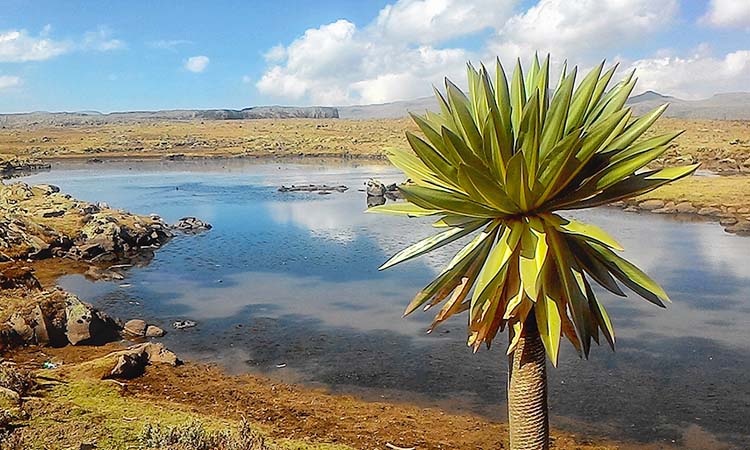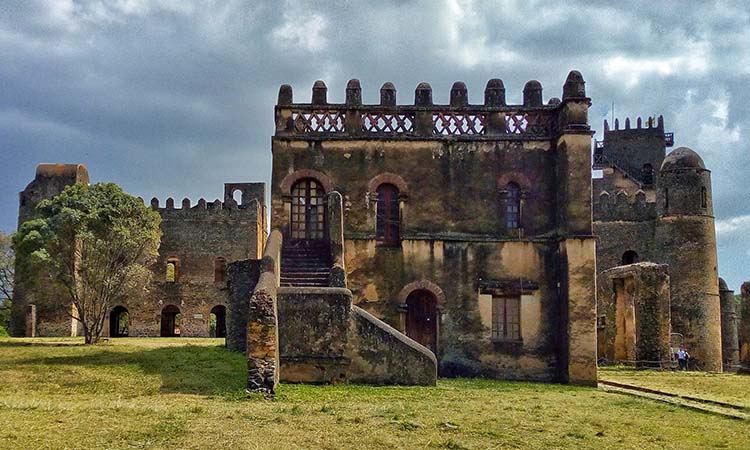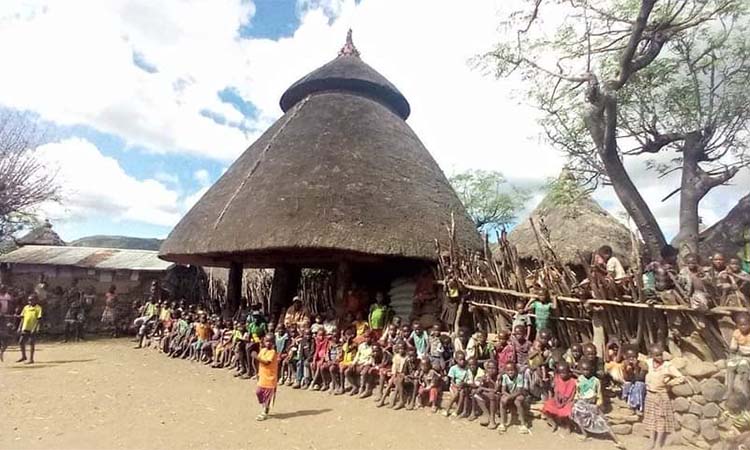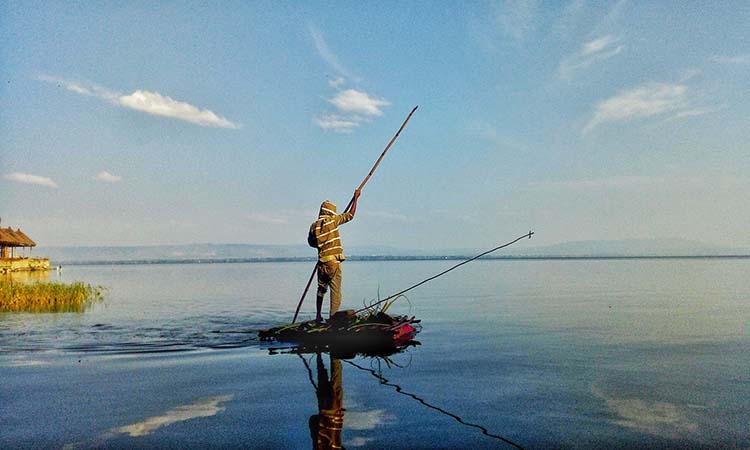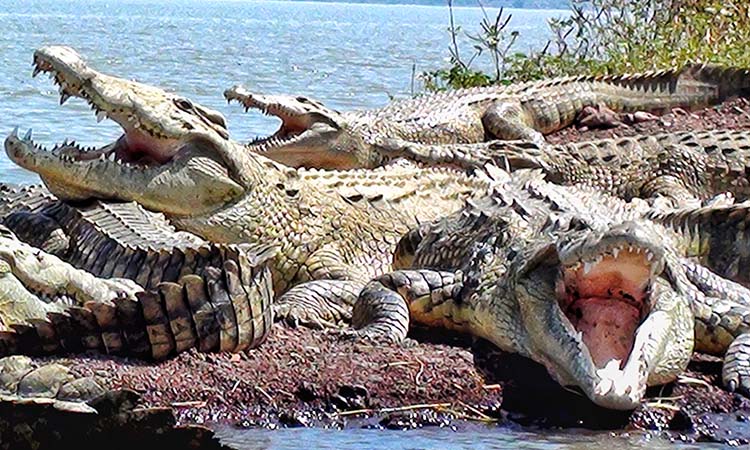Christian Pilgrimage
Highlight
Duration: 13 days / 12 nights
Transport: Air, Surface
Itinerary
Day 1: Addis Ababa
Arrive at the Addis Ababa Bole International airport. Be met and welcomed by Destiny Ethiopia Tour and Travel representative and transferred to Hotel.
Day 2: Addis-Bahir Dar
Transfer to the airport and fly to Bahar Dar. It is a modern town on the shore of Lake Tana; the source of the Blue Nile River -the largest lake in Ethiopia (3600sq.meter) is home to thirty-seven islands, of which twenty shelter churches of significant historical and cultural interest. The islands are easily reached by boat. After check into the hotel. You will have a boat excursion to visit nearest Monasteries to the southern end of the heart shaped lake, the island Kebran Gabriel Monastery, it has a large and conspicuous church dedicated to St. Gabriel, which was founded by Amda Seyon and restored by Dawit II and Iyasu II. The building is constructed using Gondar-style masonry in the round style with twelve pillars of red Danqaz stone linked by arches surrounding the cube of the maqdas. It contains paintings of fresco type on plaster, and also some others on cloth. The church is famous for its manuscripts, some of which are very old, especially old ones-an out standing one has been reproduced in the UNESCO album.The island’s secure situation led to its being chosen as a safe haven for the manuscrips from other churches endangered by the army of Ahma Gran, and several remained here afterwards. Please note that women are not permitted to enter Kibran Gabriel monastery. Continue to Zege peninsula. It is characterized by coffee production, but also, like many of the islands of the lake, preserves a rich natural vegetation. There are seven churches on the peninsula and visit Ura Kidane Mehret , consecrated to the Covenant of Mercy and Azewa Mariam, that is one of the several in the area containing frescos, elaborate painted ceilings, church crosses, crowns and attires of former Ethiopian kings and emperors. The next stop will be Narga Silassie – this large round church was built under the reign of Empress Mentuab in 18th century A.D., there are many well preserved wall paintings. There are also two remarkable and picturesque “water gates” on the opposite shores, to the west and the east, with square, two storey towers, very similar to the style of the Gondar Castles, which lead on a paved path from the water to the church. Back to Bahir Dar for Overnight Hotel.
Day 3: Bahir Dar-Gorgora-Gondar
After breakfast through the fertile land of the Amhara people to Gorgora to visit another monastery of Lake Tana- Debre Sina Mariam, a church on this site may originally date back to the time of Emperor Amda Seyon (1314-44). The decoration is said (Staude) to have been painted in the reign of Emperor Tekla Haymanot I (1706-08) at the command of his mother, Malakotawit, the wife (and murderess) of Iyasu I – the queen who was hanged for her crimes on the tree by the palace gate in Gondar. Alternatively, the Malakotawit in question may be the eldest daughter of Emperor Susneyos, and sister of Fasiladas. The church is not only in a delightful setting, but is an extremely good example of the painted round churches of Ethiopia. The first impression on entering the church is dazzling, a riot of colour and rich imagery. The church has a colonnaded outer circuit whose pillars support the outer part of the roof. The inner circular wall contains the qeddest, with twelve wooden pillars, representing the Apostles, supporting carved roof beams. Inside the qeddest is the square maqdas of sanctuary, with attractive lattice-work wooden windows.
Continue drive to Gondar, 17th and 18th century capital of Ethiopia and check into the hotel and then visit the finest of the Gonderian churches is that of Debre Birhan Silassie or ‘Trinity at the mount of light’. It was built during the reign of Emperor Iyasu (1682-1706), the church was never destroyed. It is said that when the dervishes tries to burn it in 1881 they were attacked and dispersed by bees. The church is rectangular, similar to those of ancient Axumite architecture. The inside walls of the front room are covered with paintings on cloth, glued to the surface. The ceiling is built with thick beams and it decorated with winged angel heads looking down. The wall paintings depict scenes from the life of Christ, Mary, and Saint, the Trinity. Your final visit will be at Debre Sahay Maryam, the round church of Maryam of Debre Sahay Qwesqwam, in its walled compound with square gatehouse and pepper-pot towers with upper rooms for monks’ residences, how now been rebuilt. If time will allow us we will visit The ‘’ROYAL COMPOUND” with many majestic castles constructed in the European middle age architectural style. Overnight Hotel.
Day 4: Gondar-Axum
Transfer to the airport and fly to Axum. It is the ancient capital of Ethiopia and the cradle of Ethiopian civilization. Axum is famous for its more than 2000 year old Axumite steles measuring some of them up to 33m high, the bath and palace of Queen of Sheba, King Kaleb’s and other kings tombs, archaeological museum which is widely rated as Ethiopia’s best, the church of St. Mary of Tsion, where the original Ark of covenant is housed in. Legend has it that the son of the Queen of Sheba and King Solomon of Israel, King Menelik I brought the original Ark from Israel to Axum. The compound is a well-guarded sanctuary chapel of the church of Saint Mary of Zion, where the true mosses Ark of the Covenant is housed in. It includes: the ruin of Ethiopia’s oldest church- doubtless the special position of the church of St. Mary of Tsion in Ethiopia descends directly from the earliest days of Christianity in the country, when a church was built in the city of Axum, then an imperial capital, which was destructed by the pagans in the 7th century A.D, the 17th century church erected by Emperor Fasiledes in the Gonderian architectural style, the small chapel where the Ark of the Covenant preserved in, and the newly erected modern church built by Emperor Haile Silassie I in 20th century. The crowns of a succession of Ethiopian monarchs have been preserved in the church treasury, which also housed many rich embroideries as well, as important Ethiopian Orthodox church manuscripts. Together, the three churches of St. Mary constitute a remarkable testament to the continuity of faith in Ethiopia since the very beginning of the Christian era. Overnight Hotel.
Day 5: Axum- Church of Aba Afse Debre Damo- Adigrat
After breakfast drives 50 Kms to the very small town of Yeha to visit the 5th century B.C imposing ruins of Yeha’s temple though roofless still stand. It was a large pre-Christian temple consisting of a single oblong chamber. The temple is believed to be the oldest standing building in the country. You will also visit the 6th century A.D church of Aba Afse –the church, sharing the same compound with the temple, is rectangular in shape. Continue driving to Debre Damo, a monastery which dated back to early 6th Century A.D, is said to posses the oldest existing intact church in Ethiopia. Debra Damo is only accessible by climbing up by a rope, which is made of “plaited leather”, lowered from the cliffs, which visitors tie around their waist and are then pulled up by a monk at the top of the cliffs. It is only accessible to men and male animals. Women and even female animals are forbidden to set a foot into the monastery, and must remain under the cliffs and pray from there. Continue driving to Adigrat for overnight Weldu Sebgadis or Hohoma Hotel.
Day 6: Adigrat- Rock Churches of Tigray- Mekele
After breakfast drive to the beautiful rock-hewn churches of Tigri region. And you will visit the rock-hewn churches of Medhane Alem Adi Kesho- In the rock face; one can see potholes which the local people believe to be the foot prints of St. George and his horse. The church is quite unique in architecture as the exterior has four pillars apart which have been hewn from the cliff face. All the ceilings in the church are flat and worked in different geometrical desighs which show a high standard of workmanship. At the top of the white washed front of the exterior, there are three square windows decorated with St. Andrew’s Crosses. Proceed to Petros & Paulos rock-hewn church to visit the church with two beautifully carved, wooden processional crosses. Continue driving to the beautiful rock-hewn church of Abraha Atsbeha. Its interior is painstakingly decorated: the cross imposed up on the basilica plan by giving prominence to a transept and the apparent presence of five aisles; the apse; 13 huge pillars supporting the ceiling and is rectangular in shape. The church is also decorated with splendid post-17th century murals and paintings depicting Biblical Scenes and Saints. It is also has several valuable treasures, the most important being the prayer cross which according to church officials, belonged to Frumentius- the first Bishop of Ethiopia whose ecclesiastical name was Abba Salama (Father of peace). Proceed to the other rock-hewn church of Wekro Cherkos, which was built in the 4th century A.D. and you will admire the beautiful ceiling and paintings. The interior of the church is handsomely decorated symmetrically patterned arches, columns, and carving in relief can also be inspected. Continue driving to Mekele for overnight at Axum or Hiltop Hotel.
Day 7: Mekele-Lalibela
On this day, you will have the longest drive through the rough nature of road but nice to experience along with the magnificent scenery (gigantic, ups and downs landscape). You will have a chance to visit the Ashenge Lake and good for birding. Proceed to Lalibela for dinner and overnight
Day 8: Lalibela
Lalibela stands on soft red volcanic rock and was originally known as Roha. It was later renamed Lalibela when King Lalibela was credited with building the rock-hewn churches there in the late twelfth century and early thirteenth century . It is now regarded as one of the greatest Ethiopian architectural wonders and is ranked the eighth most incredible historical site in the world by UNESCO. There are no less than 200 churches in the Lasta Region of Lalibela, some hidden in enormous caves, but it’s exceptional to find 11 churches of such master craftsmanship in one locale. These brilliant feats of engineering and architecture are often referred to as the “Eighth wonder of the world”. This day you will explore the atmospheric subterranean complex of passages and the extra-ordinary 11 remarkable rock-hewn churches of first and third group of churches (Bet Golgota, Bet Mika’al, Bet Mariam, Bet Meskel, Bet Danaghel and Bet Medhane Alem (the Saviour of the world, this is the greatest and in some ways the most impressive of the Lalibela churches. It stands on a plinth in the middle of a huge 40 by 38 m. excavation in the rock, with entry passages in the northwest and southwest corners. There are some tombs and storage caves cut into the walls of this pit. The church is rectangular, 33.5 m. long, 23.5 m. wide, and 11 m. high. In the northeast part of the church near the entrance to the sanctuary three tombs cut into the floor are shown; they are attributed to Abraham, Isaac and Jacob). Bete Giorgis (St. George) it is the most beautiful and completely monolithic cruciform church and symbolization of Noah’s Arc belong to the third group of rock church consists of a great block of red-coloured rock cut into the shape of a cross. It stands in the midst of a trench 12 m. deep. Overnight Hotel.
Day 9: Lalibela
After breakfast drive 9 km to Neakuto Le’ab built-up cave church. King Neakuto Le’ab abdicated his throne in 1270 AD in preference for a hermit life in a cave. This cave, dramatically set, has become a monastery. In houses an interesting collection of ancient crosses, illuminated manuscripts and icons some attributed to its founder Neakuto Le’ab. Drive back to Lalibela for lunch and afternoon visit the remaining second group of rock churches of Lalibela. They are four in number and they represent heavenly Jerusalem. Bet Gabre’el Rufa’el, Bet Abba Libanos, Bet Mercurius and Bet Emmanuel, this is the monolithic church symbolizes the seven Heavens. It has a basilica-like floor and is a definitive example of Axumite architecture and decoration. On the third level there are seven windows representing the seven heavens- one to the west, and three on both of its north and south faces. Overnight hotel.
Day 10: Lalibela-Addis
Transfer to the airport and fly back to Addis. After check into the hotel visit:
Be’ata Mariam Church (Menelik Mausoleum):- a building surmounted by a large gilt crown, built in 1911 by the emperor’s daughter, Empress Zawditu. The square building is made of gray stone with a central dome and four small cupolas, one on each corner. It houses the remains of the famous old monarch; his spouse, Empress Taytu; his daughter, Empress Zawditu; the Archbishop who crowned Menelik, Abuna Mateos; and princess Tsehai, daughter of former Emperor Haile Selassie I.
Trinity Cathedral:-a beautiful church with a baroque style of European architecture which is unique to both Ethiopia and Africa and is dedicated to the Holly Trinity. Here you will find scripts of the imperial families, statues done by a Greek sculpture, Stained glass window paintings from the Old and New Testament in the Bible and coffins of Emperor Haile Silassie-I; the founder of the church, and his wife. Overnight Ghion or Imperial Hotel.
Day 11: Addis- Debre Libanos Monastery-Addis
103 KM. to the north from Addis Ababa, a right hand turn leads to the ancient monastery of Debre Libanos. This is the beginning of the true gorge country for which the central highlands are renowned. Breath-taking views over chasms with a depth of 2,000 ft. or more. The old monastery itself is situated behind the new church to the right high up on the cliff.
The first Abbot of the monastery was one Tekle Haymanot (1260) later canonized. The Abbot is titular head of the monastery and has always been regarded as the premier monk of the land. The new church stands beneath a cliff on the edge of the gorge. It has beautiful stained glass windows and before you enter, It is worth noting the mosaic figures on the façade. You can stop and spread a picnic lunch halfway between the turn off and the church. Gregarious gelada baboons peer curiously at the visitor while birds of prey soar overhead.
Drive back to Addis and visit Merkato:-It is the largest open-air market in Africa. Here you will be presented with a confusing, but fascinating; glimpse of the vast range of goods and artefacts available from all parts of the country and enjoy the Ethiopian trade exchange tradition in the open air.
Evening a fare well diner party in one of the Traditional Ethiopian restaurant with dances from the different ethnic Groups. Transfer to the airport for your international flight and departure back to home.

